[Columns are a regular weekend feature at The Wild Hunt. Each Friday and Saturday columnists from various backgrounds and traditions share their perspectives and add their insights to the larger conversation in the community. If you like this feature, consider making a small monthly donation or make a one-time donation toward this vital global community venture. Either way, it is your help and your support that keeps daily and dependable news coming to your doorstep each day from wherever its origin.]

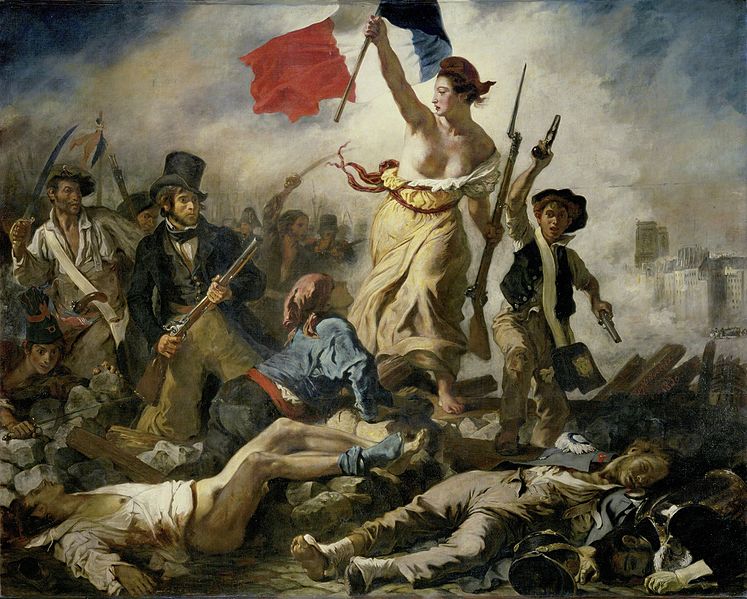
Liberty Leading the People by Eugène Delacroix
Back when I was a little kid, something like 20 years ago, my mother took me on a trip to Paris. For about a week, we wandered around the city of lights, visited friends, took the metro, ate crepes, climbed the Eiffel tower and more. On the morning of our last day there, my mother told me we only had time to visit one more place before going home and that I’d have to choose between Disneyland or… the Louvre. I chose the Louvre.
While my recollection of visiting the world’s largest museum some twenty years after the fact is patchy at best, there are still a few things I remember with quite some fondness. Things like admiring the insane size of Jacques-Louis David’s The Coronation of Napoleon (1808) before coming across the even larger The Wedding at Cana (1563) of Veronese. I spent many hours in the museum, feeding my eyes on all sorts of artistic and historic wonders; I even managed to get a glimpse of the Mona Lisa. Yet, the clearest memory I have from this most-colorful day was my meeting with a woman, a certain Marianne.
Marianne was an outstanding lady by all accounts. Coiffed with an odd-looking red bonnet, holding a flag in one hand and a gun in the other, she was still, yet exulted a powerful sense of urgency; she barely wore any clothes, revealing her bare breasts, all the while retaining a noble aura. A mystical je-ne-sais-quoi emanated from her slick and oily two-dimensional figure. Standing atop the fallen, haranguing a mismatched crowd of warriors, Marianne looked as if she had stepped out of a myth still in the making, only to pose as the main figure of Delacroix’s masterpiece La Liberté guidant le peuple – Liberty Leading the People (1830).
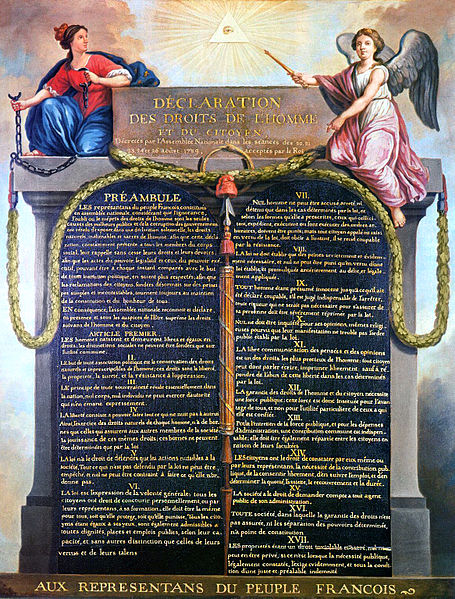
Declaration of the Rights of Man and the Citizen of 1789
The world-famous painting, rather than being an accurate representation of the Revolution of 1830, is an allegory representing the personification of the nation, Marianne, guiding the hands of the Parisians. While the exact origin of Marianne is hard to pinpoint, she emerged in the context of a renewed interest in the arts and culture of the classical world. Both before and after the Revolution of 1789, the depiction of the history and mythology of the ancient Romans and Greeks became common in France. One family of figures in particular quickly gained near-universal appeal, the genii, the divine protective spirits of ancient Rome. As early as the summer of 1789, a female genius (singular of genii) of the nation appeared on a depiction of the Declaration of the Rights of Man and of the Citizen, alongside a female allegory of the royalty and an all-seeing eye.
Three years later with the abolition of the monarchy, the depiction of near-divine female figures used to represent ideas of nationhood, freedom, reason or the motherland became all the rage. The development of this new quasi-religious figure coincided with the decline of Christian influence in the country. From the middle of 1792, the revolutionary government started to engage in conscious efforts of de-Christianization, which included a policy of seizing the assets of the Church, banning the public display of Christian faith as well as the establishment of competing cults. Two successful cults in particular, emerged from this tumultuous period, the Cult of Reason, and the Cult of the Supreme Being, with both of them making use of the imagery of the divine feminine. One remarkable event that took place in Notre-Dame de Paris, by then a disaffected church, saw the once cathedral turned into a “Temple of Reason” where a republican liturgical celebration, “the Feast of Reason” was performed for the public. There, an allegorical amalgamation of “Reason” and “Liberty” was placed unto an altar-like makeshift mountain accompanied by a series of musical numbers sung in her praise.
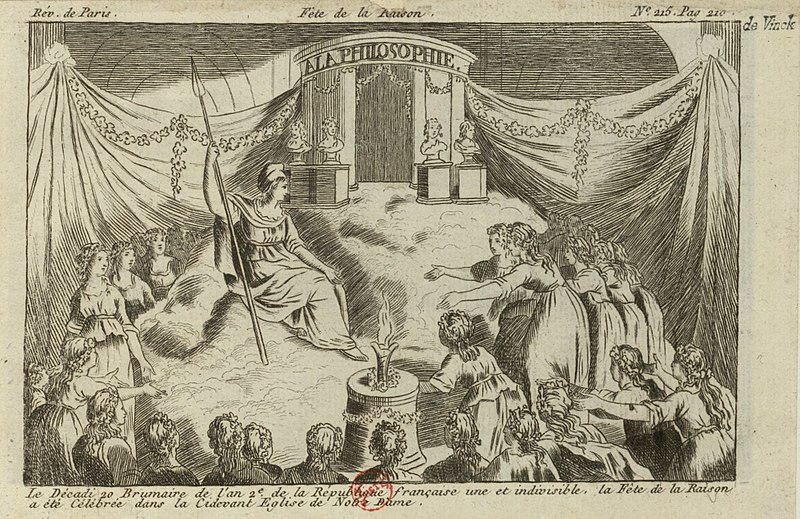
The Feast of the Reason at Notre Dame in 1792
While the development of these Roman-inspired civic cults came to a progressive halt before being outright banned by Napoleon a few years later, the female figure of Marianne, a fusion of the ideas of freedom, republic, reason, revolution, wisdom, and nationhood survived. When I first met her, some two centuries after her emergence, I honestly had no idea who she was, where she came from and what she was supposed to represent. Yet I still remember the unexplainable attraction I felt for her that day, a sentiment that became an influence for me during my formative years. During my teens, my infatuation with the Goddess of Freedom only grew as my near-obsession about all things related to the revolution reached its apex. I recall regularly singing the praises of Robespierre, celebrating the death of kings and even, this is somewhat embarrassing, ditching the Gregorian calendar altogether in favor of the French Republican Calendar. I have mellowed considerably over the years, and have adopted a much more critical (and factual) attitude towards the revolution. I now understand that what fascinated me about this period was not, in and of itself, the politics of it. I rather fell for the movement’s radical (and back then, unprecedented) rejection of the Judeo-Christian mythos and its modern adoption of Pagan iconography and ideals. In many ways, the revolution, heralded by the genius of Liberty, was one of my unconscious gateway drugs to the Old Religion.
As I became older and, I want to believe, wiser and more knowledgeable in the ways of the gods, I started looking back to my younger days and my admiration for Marianne. Besides her more straightforward origins as the genius of Liberty, could she possibly occupy a place in the mythos and worldview of modern Pagans that might never even have heard of her? What does she represent and stand for nowadays? These are all questions I have been pondering for many years and which I believe should ultimately be addressed.
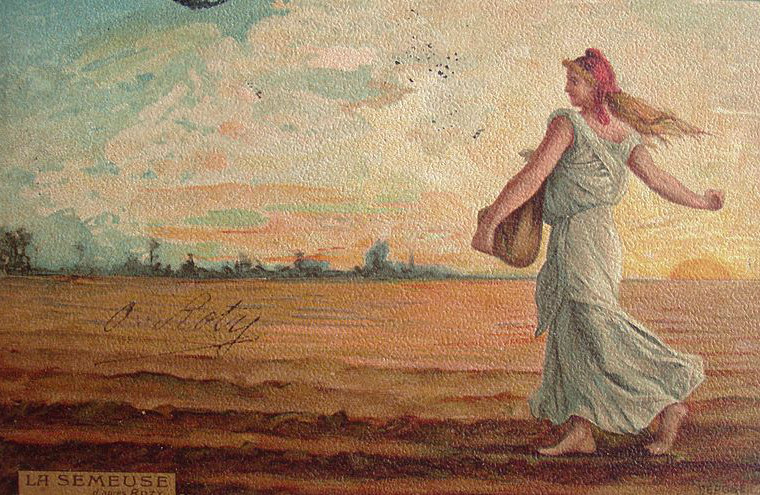
The sower by Oscar Roty
One main issue when discussing Marianne is defining her. In most people’s minds, she is the representation of the republic, the French peoples’ now preferred system of government. As a republican symbol, Marianne was often referred to as la gueuse (the wench) by monarchists. However, in modern France, the concepts of the republic, and the concept of France tend to be blended, both by the public and by the institutionalized powers. In practice, Marianne has become the genius of the nation, taking on multiple forms depending on the context. The representation that most people know of her is arguably la seumeuse (the sower), a design dating back to the end of the 19th century, representing Marianne as the sower of the seeds which will bring about peace and prosperity. In a fitting way, this design has been widely used on all types of common coins from the francs of the 1960s all the way to today’s euros. While it is true that the French state has made an extensive use of the figure of Marianne and even included her in their official logo, in practice, Marianne cannot be limited to a mere allegory of a form of government.
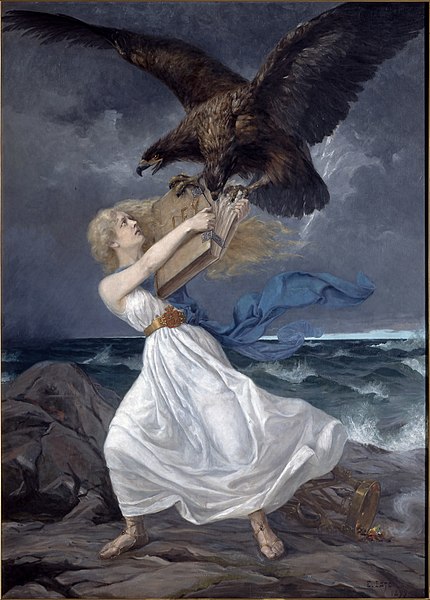
The Finnish maiden by Edvard Isto
This is all the more true when looking at the countless metaphorical national figures that have emerged in and around the same period as Marianne. Figures like Columbia for the United States of America and Britannia for Great Britain are fairly well-known among the general public. In Europe, other female allegories like moder Svea (Mother Svea) for Sweden, the Finnish-maiden for Finland, Fjallkona (the mountain lady) for Iceland, Germania for Germany or even Ériu for Ireland are all cultural symbols that carry weight in the popular consciousness. While most citizens of the aforementioned countries don’t actively worship their national genius, these figures often emerge in times of need, controversy, or national crisis. During the first World War, Marianne was often depicted on propaganda posters, postcards and other media. There, she sided with the French soldiers, lead them to victory or healed their wounds. In times of crisis or when tragedy strikes, Marianne is still routinely pictured distressed, prostrated, shackled, or instead, combative and vengeful.
Like a deity of old, which would receive various epithets and bynames depending on the occasion, the place of worship and the liturgy surrounding her cult, the Goddess of Freedom of today is equal parts bellicose Valkyrie, wise matriarch, loving maiden, and grieving mother. Her versatile nature has made her into one of the most recognizable figures in the world. Alongside other deities that have survived or reemerged in popular consciousness like Justitia, the enduring appeal of the Goddess of Freedom shows that even in our desperate and godless times, the Gods will find a way to us, and we will find a way to the Gods.
* * *
The views and opinions expressed by our diverse panel of columnists and guest writers represent the many diverging perspectives held within the global Pagan, Heathen and polytheist communities, but do not necessarily reflect the views of The Wild Hunt Inc. or its management.

Save Pagan journalism
Donate today
SaveSave
SaveSave
SaveSave
SaveSave
SaveSave
The Wild Hunt is not responsible for links to external content.
To join a conversation on this post:
Visit our The Wild Hunt subreddit! Point your favorite browser to https://www.reddit.com/r/The_Wild_Hunt_News/, then click “JOIN”. Make sure to click the bell, too, to be notified of new articles posted to our subreddit.
